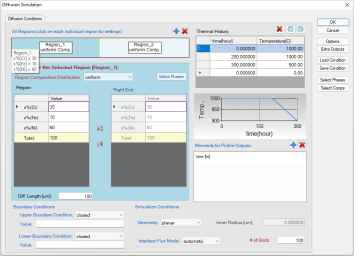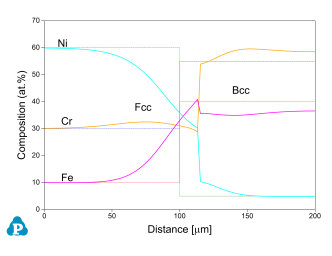Diffusion between Two Phases at Varied Temperatures
Purpose: Learn to perform diffusion simulation at varied temperatures for a diffusion couple with the two sides having different phase structure and uniform composition through each side before diffusion.
Module: PanDiffusion
Thermodynamic and Mobility Database: FeCrNi.tdb
Batch file: Example_#4.4.pbfx
Calculation Procedures:
-
Create a workspace and select the PanDiffusion module following Pandat User's Guide: Workspace;
-
Load FeCrNi.tdb following the procedure in Pandat User's Guide: Load Database , and select all three components;
-
Click on the menu "PanDiffusion → Diffusion Simulation" and set up the calculation condition as shown in Figure 1. First select "Region Composition Distribution" as Uniform, which means that composition in each region is uniform before diffusion. Click on Region_1 and set the composition of the left side of the diffusion couple as 30Cr-10Fe-60Ni (at%), then click on Region_2 and set the composition of the right side of the diffusion couple as 55Cr-40Fe-5Ni (at%) (which is not shown in Figure 1).
-
The length of both Region_1 and Region_2 is set to be 100 mm, and the total number of grids (# of Grids) is 100.
-
The Thermal History is holding the diffusion couple at 1000°C for 200 hours, then the temperature decreases from 1000°C to 900°C linearly in the next 100 hours.
-
Click “Select Phase” and set Fcc and Bcc as the entered phases.
-
In the settings shown in Figure 1, composition profiles only at the initial and final stages will be outputted. Click OK to perform calculations.
Post Calculation Operation:
-
Change graph appearance and add text following the procedure in Pandat User's Guide: Property. The calculated plot is show in Figure 2
Information obtained from this calculation:
-
After holding the diffusion couple at 1000 °C for 200 hours, the temperature decreases gradually in the next 100 hours to 900 °C. Composition profiles after the entire thermal history can be obtained;
-
Learn to set up multi-step thermal history for a diffusion simulation.

